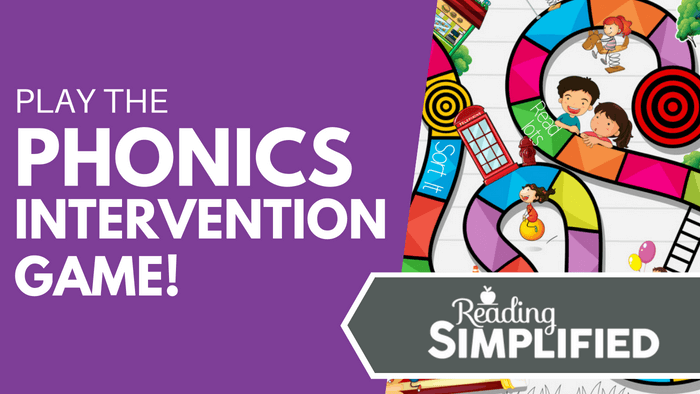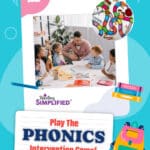
Most struggling readers have poor sound-based decoding skills, which means they lack the core foundation of being a good reader. They’re unable to line-up each sound of a word with each individual letter sound and thus, reading breaks down.
But what if I told you there was an intervention plan that solves most reading problems for kids of all ages?
In other words, I’ve created a streamlined roadmap that shores up the sound-based decoding foundation whether the child is a second grader OR a tenth grader.
That’s right! You can rely on this FREE Phonics Intervention Game to help struggling readers build their sound-based decoding skills, word identification, fluency, and comprehension.
And what’s more, you can do it using this fun Phonics Intervention Game that’s easy to navigate, and the kids love it too, score!
(Read on to find out more about the game, or watch the video below)
The Game of Intervention
The Phonics Intervention Game is designed to solve kid’s reading problems in just a few weeks with around six to 12 hours of instruction. The roadmap is the same as the one I used for two different students.
The first was a 10th grader who struggled with sound-based decoding and “Word Attack.” In April, he scored just 1.7 in the Word Attack pre-test. However, by the time August rolled around, his score skyrocketed to 10.0!
He improved his reading skills across the board, rising his Word Identification skills from 9.0 in April to 9.2 in August. Passage Comprehension also grew from 5.7 in the pre-test to a massive 16.9 in the post-test – now that’s what I call accelerated achievement!
I used the same roadmap for a 2nd-grade student, and she worked for six hours over a period of two months. Her sound-based decoding skills started at around 2.0 in April and jumped up to 3.7 in June. To put in perspective, that’s seven months’ worth of growth in just two months!
So, let’s get into The Game of Intervention and go over how this fantastic game works!
Assess with Nonsense Words
The first step of the game is to assess your students with a nonsense word test to uncover the reader’s sound-based decoding ability.
Research shows that a nonsense word reading test is the NUMBER ONE diagnostic test to identify the source of most reading problems. It’s an important test because it accurately picks up the student’s weakness.
The student can’t rely on their memorization skills for this one, because they’ve never seen these nonsense words before and therefore, they have to use sound-symbol processing skills to solve the puzzle.
With just 12 hours of teaching time using The Game of Intervention, students reach above grade level outcomes in not only sound-based decoding but Word Attack, Word Identification, Fluency, and Comprehension.
You can find out more about assessing kids with nonsense word tests by reading this blog post, “Reading Tests That Inform Instruction” and downloading the FREE Nonsense Word Reading Tests included at the bottom of the post.
Group your Students
If you have more than one student, group them based on their Word Attack knowledge. This will make things easier for you as the teacher, so you can focus on each small group separately and work on practicing the areas that NEED practicing.
If you’d like to find out how you can group your students for accelerated reading instruction and performance, visit “A Small Group Guided Reading Structure for Accelerated Reading (and Less Teacher Stress!!)”
The Switch It ACTIVITY
The first activity the kids are going to try is Switch It. It’s the easiest phase of the game where kids can have fun manipulating letters and sounds in and out of words with a strong focus on the sounds.
Switch It improves:
- Phonemic Awareness
- Phonemic Manipulation
- Phonemic Segmentation
Not only that, but Switch It integrates all of these reading skills (including handwriting and spelling) into one 5 – 10-minute instructional activity.
Sounds pretty good right?
Switch It combines multiple sub-skills and builds phonemic processing skills, which is usually the core of the problem in the first place! We can do this activity with all age groups by merely advancing the difficulty levels depending on their grade level.
When I worked with the 2nd grader, I started her with four sound words such as HELP. However, the 10th grader was able to work with five or six sound words such as SLINT or SPLONT.
Want to find out more about the Switch it activity and get the how-to’s and word lists in our FREE Switch It Packet? Grab yours over on the “Integrate, Don’t Isolate: Teach Multiple Reading Skills Simultaneously” blog post!

Read It
As you move along the roadmap of this exciting little game, you’ll eventually reach the “Read It” green marker. Read It works hand in hand with Switch It and you can do both of these activities simultaneously.
Read It is where the student reads the word by putting the sounds of the letters together as they go using the Blend As You Read STRATEGY.
Check out this blog post, “One and Done….Nearly” for more information on Read It and to find out where you can get your hands on the FREE Read It Packet, which is designed to help solve your kids blending problems.
Read Text
When you’re teaching students to improve their sound-based decoding, you need to encourage them to read aloud. Doing this allows the student to practice reading a text while giving you the opportunity to catch any issues that may require additional practice.
You can coach them on the words they don’t know, but make sure that the text they are reading is in line with the phonics you are teaching. So, if the student struggles with short vowels, give them a text with plenty of short vowels.
If you’re not sure how to identify reading errors and need a helping hand, head over to this post, “The 411 on 4 Types of Reading Errors” for more advice on this phase of The Game of Intervention.
Sort It
When you reach the second stage of the game, your student is ready to try the Sort it Activity.
Sort It works with advanced phonics such as the “o” in “Joe,” “Note” and “Show” etc.
Sort It focuses on high-frequency words of a particular target sound, such as the “o” we discussed above. One of the best advantages of this activity is the fact that it integrates multiple CCSS simultaneously in just one phonics activity.
How great is that?
Learn more about the Sort It activity here; “Power Up Your Phonics Activities” and don’t forget to snag your free Sort It Packet (scroll down to the bottom of the page to find it!)
Multi-Syllable Words
If your kids are struggling to read multi-syllable words, you can start teaching them in the same way as you did with Sort It. But once you reach this stage, you need to begin increasing the challenge by adding multi-syllable words into the mix.
It’s quite a big transition, so don’t worry if your kids don’t pick it up right away!
Join me over on this Facebook video where I talk about how you can use Read It to improve the core strategy that kids need to read multi-syllable words successfully!
Fluency
Once you reach this stage of the process, you’ll need to focus on transitioning your coaching towards the reader's fluency. Yes, we’ve been doing fluency practice all along, but now it’s time to start emphasizing it for your kiddos!
By this stage, your kids' underlying sound-based decoding skills should be pretty good. After all, they’ve come this far and have practiced word work, reading decodable texts and re-reading decodable texts. They may need some more practice, but at this stage, you can reduce the amount of time they spend reading a new text and increase the time they spend re-reading to help improve their fluency.
If you’d like to learn more about re-reading for fluency, you can check out this Facebook video from last year where I discuss this topic further.
Expand Reading Horizons
Congratulations! – you’ve reached the end of the game!!

Take a bow because that was a lot of work…yet it was still a lot more efficient than traditional teaching methods!
At this stage, your student's sound-based decoding foundation, word identification, and fluency skills should have improved. Now that you’ve completed The Game of Intervention, it’s time to read A LOT.
Encourage your kids to read widely and frequently. Increase the amount of time they spend reading (and talking about the text they read) per day because you want to keep that reading foundation strong!



so informative
Great idea
Thanks Juanita! 🙂
Very useful and informative.Thanks
May it serve your readers well, Maria!